ACTION ANIMATIONS
...or, 'Hop, Skip and Jump'
So, we have idle and we have weapons animations, now we need to cover more
complex issues like run, jump, walk, swim etc..
The key thing to remember with action animations is to make them exagerrated and
over the top. It needs to be obvious even from a distance what that model is
doing in the game, which is the whole point of adding more detailed animations
to an FPS in the first place.
I am not going to cover all of the previously mentioned animations, because the
principle remains the same behind all of them. I will show you how to make a
simple walk cycle and that, combined with studying the relevant SMD files in the
SDK should give you enough knowhow to make the other animations yourself.
Open your base skeleton file.
First things first. Set the length of the walk cycle to the relevant length. A
standard walk cycle is 24 frames. However, we will set our animation length to
25, because we will have the 25th frame the same as the first one.
Consider the movement that your biped is making. At present he is stood in a
neutral fashion as if he's contemplating his impending fragging. In reality if
you walk continuously, you don't take two steps and return to a neutral position
before continuing, do you? My point is this: Your skeleton needs to move into
the walk cycle from the same position that he ends it. So you'll need to
position your skeleton as if it's just completing a walk cycle:
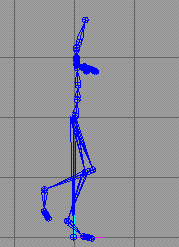
Now activate the animation button and set the keys for the start and finish
frames.
It is possible in the nice, shiny new version of Milkshape, that has come out
since I started writing this tutorial to now copy keyframes. Select all of the
joints at frame 0 and set keyframes as usual. Now select 'Copy Keyframes' from
the same menu and then move the slider along to the last frame, 24 and select
'Paste Keyframes'. This will position the skeleton exactly as it is in the frame
you copied the keys from.
During the course of the animation the biped walks forward a little over 56
units. So, select Joint Bip01 and with the animation button activated and the
slider over to the right on the last frame, move the diamond forward 56 units.
You can count the units in the XYZ position counter at the bottom,left of the
screen. Now set a keyframe for that joint.
Now, if you play the animation your biped will mysteriously hover over to the
end position in the walk cycle. We need to make him use his legs in the process
of traversing that distance now. The walk cycle will be ideally divided into 6
equal sections, with a set of keys at each section. I have illustrated the six
sections here.
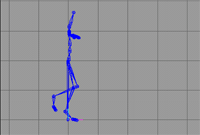
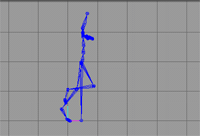
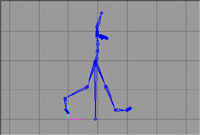
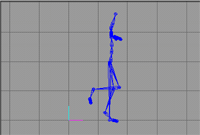
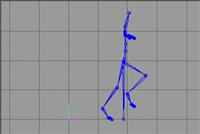
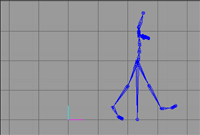
Image one is at frame one. Image two is at frame 5. Image three is at frame 9
and so on and so forth. Image six should be at frame 21. This leaves four frames
to return the model back to the start position.
This may well get vague and confusing. I'll do my best to explain it carefully.
The six sections are ideally essential positions that we need the biped to be in
at those specific frames in the animation. During the course of the animation
the skeleton will take two steps and finally return to the position he started
off in but 56 units forward of his starting position. Studying a walk cycle, I
determined that dividing the cycle into six sections yielded these positions as
the most obvious.
We have already positioned our skeleton at frame 1 in the pose of picture 1.
That is the start position, so, with the animation button activated, I move the
slider forward to frame 5 and position the biped skeleton as in picture 2:

Then, I move the slider to frame 9 and I position the Biped as in image 3. I
keep repeating this until I reach frame 21. Now there are four frames left which
bring us neatly back to the original stance at frame 23. Now, it's no good
having the start and finish loop exactly the same because you'd have two
identical frames in a row, so now in the frames counter at the bottom right,
reduce your number of frames from 25 to 24 and the animation should now rotate
smoothly into the first frame.
Play the loop and, BEHOLD! He walks,
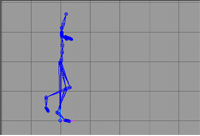
...sort of, but it's a good base to build on. We are going to need to adjust the
legs at certain points to make the walk more convincing.
Things to consider aswell, are that when someone walks, their whole body shifts
from one foot to the other. The whole body raises as the walker lifts themselves
up off their foot and sinks as it comes down on the other foot. Also, as the
walker shifts their weight on to one foot to raise the other, they pretty much
centre their weight on that foot, this means that feet are centred as they pass
under the body's centre of gravity. This is just a couple of many, many things
that you need to consider when animating, especially natural movements, which
tend to flow and ebb smoothly with all number of wierd and subtle quirks. Once
again, as with modelling and skinning, STUDY! Study movement, nature videos,
watch people, study other animated models.
That's it. That's about all I can teach you for now. As I said in the
introduction, I will probably update this tutorial as I learn new stuff and
learn the existing stuff better. I might even add to the existing stuff, because
I've barely scratched the surface on a lot of it. It's up to you now to
experiment, practice and just simply have fun.
Tutorial created by Scarecrow,
THANK YOU !!!
©
http://www.Planetfortress.com/TF2Models
TF2 is trademark of Valve
Software and of Sierra Online.
© 2000 TF2 MODELS - Hosted by Planetfortress
Web designer/Webmaster : IXNAY









